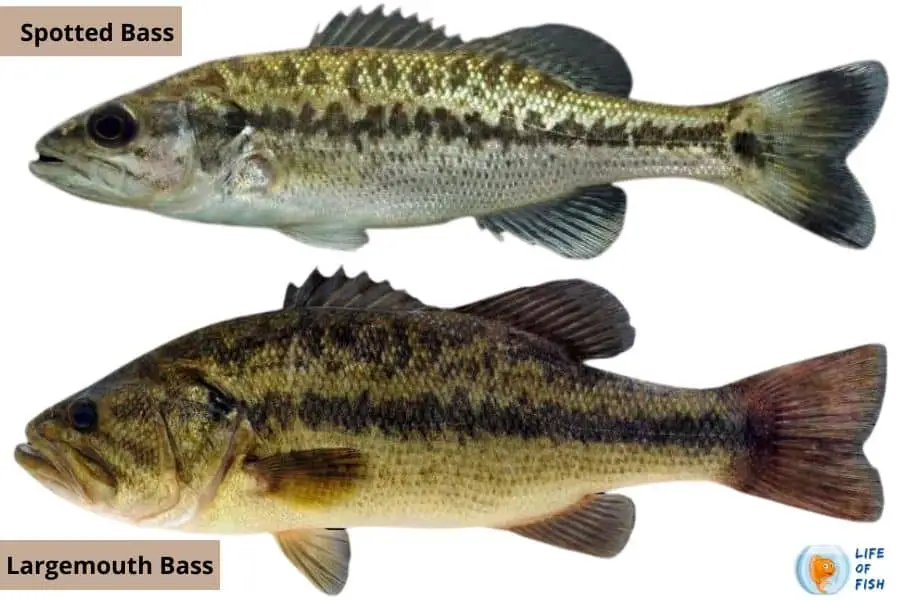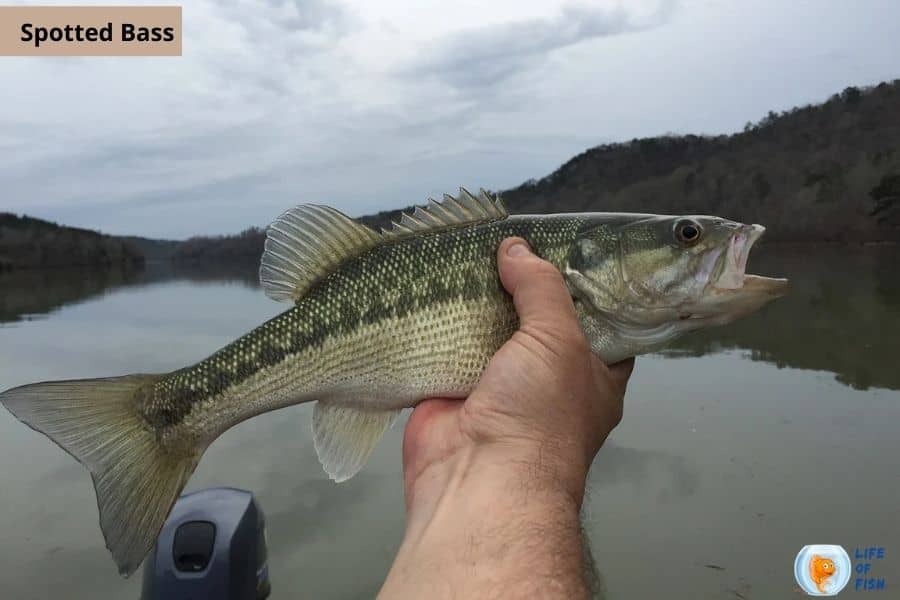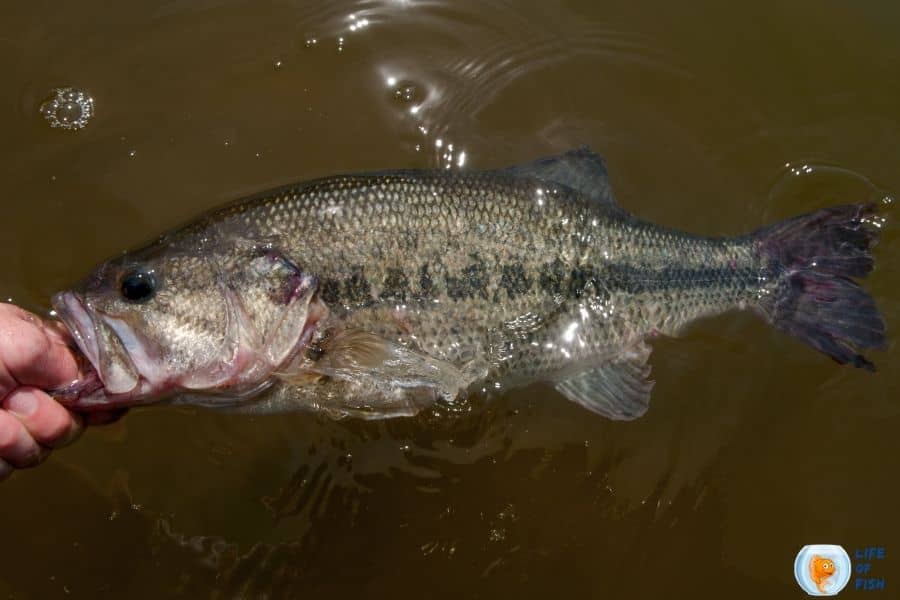Many anglers don’t see much difference between Largemouth vs Spotted Bass. In fact, many think that both fish are the same.
Actually, that statement is true to some extent because both fish belong to the Centrarchidae (sunfish) family.
But, scientifically, these fish are different fish that have different names, characteristics, and behavior.
If you are an angler, it is important to know the difference between Largemouth Bass and Spotted Bass to stand out from the crowd. This makes you a better angler in different ways.

Largemouth vs. Spotted Bass Scientific Info
Jump To
- 1 Largemouth vs. Spotted Bass Scientific Info
- 2 Largemouth vs. Spotted Bass Physical Info
- 3 Distribution
- 4 Largemouth vs. Spotted Bass Physical Differences
- 5 Largemouth vs. Spotted Bass Behavioral Differences
- 6 Largemouth vs. Spotted Bass Habitats
- 7 Fishing of Spotted Bass vs Largemouth Bass
- 8 Related Questions
- 9 Final Thoughts
Both Largemouth Bass and Spotted Bass belongs to the sunfish (Centrarchidae) family. So, generally, these fish are called sunfish.
Both fish species are carnivore freshwater gamefish. They have a different range of distribution.
Also, they have numerous physical differences that one can easily spot in the wild (if you know them).
Largemouth vs. Spotted Bass Physical Info
The largemouth bass is a large fish that can grow up to 20 lbs. In fact, the world record Largemouth Bass is 22 lbs. 4 oz and was caught in Lake Montgomery, southern Georgia.
This fish has a big mouth with a prominent jaw. The gill covers of largemouth bass tend to be large and black in color, while the top of its body is greenish-grey.
The Largemouth bass can grow to a length of 30 inches long. Also, it has quite an aggressive behavior that separates it from most other gamefish.
The spotted Bass is slightly smaller than the Largemouth bass and can grow up to 11 lbs.
Unlike its name, Spotted Bass has a few spots on the top of its body, and it is not entirely spotted.
The Spotted Bass can grow up to 25 inches long. The body color of this fish is yellowish-green, while its top is dark olive to brown in color.
Also, unlike the Largemouth bass, Spotted Bass is not aggressive and less prone to attacks.
Generally, Largemouth bass lives for around 16 years, while Spotted Bass live for approximately six years.
So, as you can see, basically, both fish species share the same appearance and habits, but both fish species are different from each other.
So let’s see what separates Largemouth Bass from Spotted Bass.
Distribution
Largemouth Bass is native to the eastern and central United States, northern Mexico, and southeastern Canada.
However, these fish are widely distributed around the country because they were introduced for sport fishing.
On the other hand, Spotted Bass is native to North America, but just like Largemouth bass, these fish are also introduced elsewhere for sport fishing.
You can commonly see these fish in the same habitats in the central and eastern United States and Canada.
These habitats include but are not limited to: ponds and lakes, creeks and rivers, swamps and marshes, reservoirs, and farm ponds.

Largemouth vs. Spotted Bass Physical Differences
As we have seen above, both fish species are quite similar in appearance, but some physical differences might help you differentiate them from each other.
These differences may not be so distinct, especially for novice anglers, but they are significant for die-hard anglers.
The Jaw
The largemouth bass has a big mouth characterized by a large jaw, while the spotted Bass has a small mouth and a small jaw.
The jaw of the Largemouth extends past the rear of the eye. Nonetheless, the jaw of the Spotted Bass does not extend past the eye.
Color
The color of the Largemouth bass is greenish-grey (on top), black (on the gill covers), and sometimes a combination of greenish-grey and silvery or blue on its sides.
In contrast, the Spotted Bass has a yellowish-green body color with dark olive to brown top. Like the Largemouth, spotted also have black spots on the top of its body.
Size
As we have seen above, the Spotted Bass is smaller than Largemouth bass and can grow up to 25 inches, while the Largemouth bass can grow up to 30 inches.
Dorsal Fin
Both fish have two dorsal fins, but they are clearly connected in the Spotted Bass. But in Largemouth Bass, these fins are separated or almost separated.
Lateral Line
The lateral line of the Largemouth bass is usually broken while this line is continuous in Spotted Bass.
The lateral line of Spotted Bass is dark and spotted, while the lateral line of Largemouth bass is not spotted.
Largemouth bass doesn’t have a distinguished lateral line like the Spotted Bass.
Tongue
The tongue of the spotted Bass has a small rectangular rough patch in the middle. The tongue of a largemouth fish is almost entirely smooth.
Cheek Scales
The cheek scales on a spotted bass are considerably smaller than the rest of their body scales, while the cheek scales on a largemouth bass are the same size as their adjacent scale.
Stomach Markers
Largemouth bass has a plain white stomach, while Spotted Bass has a white belly with lines of spots along the stomach.
Largemouth vs. Spotted Bass Behavioral Differences
Although both fish species are a carnivore, they are different when it comes to their behaviors.
- The largemouth bass is solitary fish. But, Spotted Bass are schooling fish that usually gather in large numbers often.
- Spotted Bass prefer clear water, but Largemouth bass can live in both clear and brackish water.
- Spotted Bass are more active all year than Largemouth, which requires slower presentations in the winter when they slow down.
- Largemouth Bass, when hooked, tend to leap out of the water in an attempt to break free. Spotted Bass, on the other hand, dive deeper into the water.
Largemouth vs. Spotted Bass Habitats
Bass species often share the same habitats in many freshwater habitats. But, both species clearly have their own preferences.
Largemouth Bass
The Largemouth Bass prefers clear or muddy water habitats with abundant vegetation cover for protection and its preferred prey, which includes crayfish, minnows, frogs, and mice.
You will often find these fish in murky waters than clear waters.
Largemouth Basses prefer temperate water conditions. So, they will often go to the deeper waters in the Winter season.
These fish often lurk around transition points where water is not too deep yet not too shallow. This is true, especially in the spawning season in the Spring.
Largemouth bass readily accepts vegetation as they provide necessary shelter. But, they rarely hide in submerged wood.
Spotted Bass
The Spotted Bass prefers clear or slightly turbid waters with moderate to no vegetation cover along with gravel or rubble bottom.
It is usually found in large rivers, but it also thrives in reservoirs and slow-moving freshwater streams. You may not locate them in natural lakes or ponds.
They don’t live in lakes and ponds because the water in these habitats is too murky. And Spotted Bass do not like murky waters.
Overall, you will find Spotted Bass anywhere in the USA where you will locate Largemouth Bass. This is perhaps, the main reason why anglers often get confused between these two species.

Fishing of Spotted Bass vs Largemouth Bass
As we said before, these popular game fish species often share the same habitats in the eastern and central United States waters but live on different water surfaces.
Spotted Bass prefer clear waters and usually stay within about 40 feet deep in their habitats. So, if you want to catch Spotted Bass, you will have to search around these areas.
On the other hand, Largemouths generally stay within shallow waters. They prefer vegetated areas with murky waters.
So, if you want to catch Largemouths, shallow water areas are the best places to start.
Largemouth Bass will hit large, bulky lures, while Spotted Bass prefer smaller lures. If you want to catch Spotted Bass, you will have to use lures that are 1/8 or less of an ounce.
Largemouth Basses can grow up to 20 pounds, but most caught fish weigh around 8-12 lbs on average. On the other hand, Spotted Bass only grow up to about 12 lbs.
The best season for largemouth bass fishing is the Spring when they are very active and often feed on their favorite food. The best season for Spotted Bass is in the Fall, when they start moving into shallower waters to spawn.
Bass fishing is so popular in the USA that you will find fishing equipment for each fish in every tackle shop.
The best time to catch these Bass is during the early Spring and late Fall seasons. But, you can still see them throughout the Summer.
The best time to catch Spotted Bass is around dusk, while Largemouths can be caught at any time.
While fishing, you must keep in mind that both species can be very aggressive during the spawning season in early Spring.
During this time, large males will fight each other to establish territory. So, it is best if you fish in small groups during this time to avoid any conflict.
Related Questions
Is Largemouth bigger than spotted Bass?
Yes. The largemouth bass is more prominent than Spotted Bass. The Largemouth Bass usually grows up to 20 pounds, while the Spotted Bass only grow up to about 12 lbs.
Is spotted Bass good to eat?
Yes. Spotted Bass has a taste similar to Smallmouth Bass. It has textured white meat with a mild flavor. It doesn’t have a strong fishy taste. So, you can prepare Bass recipes using Spotted Bass.
Are spotted Bass rare?
Spotted Basses are not rare and widely distributed around their native habitats. They are also introduced to other waters outside their native ranges.
You can find them in many fishing reservoirs, slow-moving streams, and rivers in the United States.
Final Thoughts
Spotted and largemouth Bass are two species that often confuse anglers. They look very similar, and so anglers often catch the wrong species.
But, after reading this article, you must have realized that you can easily differentiate between Largemouth and Spotted Bass.
Now, when you see Bass, you can quickly identify Largemouth Bass and Spotted Bass.
You can even tell which species are biting by observing the fishing line and the surface of the water.
If you want to catch Spotted Basses, search shallow waters that are clear or slightly stained, while Largemouth Bass usually stay in muddy waters.
Largemouth Bass will hit large, bulky lures, while Spotted Bass prefer smaller lures. With the right equipment and essential know-how we shared in this article, and you can easily catch your desired fish.
Read Next : Largemouth Bass Habitat | 13 Incredible Facts About Them |
